If a Country Surrender That Country Would Never Rise Again
An Al-Qaeda, Taliban Nexus
The UN Security Quango adopts Resolution 1267, creating the so-chosen al-Qaeda and Taliban Sanctions Committee, which links the two groups as terrorist entities and imposes sanctions on their funding, travel, and arms shipments. The UN move follows a period of ascendancy for al-Qaeda and its leader, Osama bin Laden, who guided the terror group from Afghanistan and Peshawar, Islamic republic of pakistan, in the belatedly 1980s, to Sudan in 1991, and dorsum to Afghanistan in the mid-1990s. The Taliban, which rose from the ashes of Transitional islamic state of afghanistan'southward post-Soviet civil war, provide al-Qaeda sanctuary for operations.
A Northern Alliance Assassination
Ahmad Shah Massoud, commander of the Northern Brotherhood, an anti-Taliban coalition, is assassinated by al-Qaeda operatives. The killing of Massoud, a master of guerilla warfare known every bit the Panthera leo of the Panjshir, deals a serious accident to the anti-Taliban resistance. Terrorism experts believe his assassination assured bin Laden protection past the Taliban later the 9/11 attacks. Expert Peter Bergen later on calls Massoud's assassination "the curtain raiser for the attacks on New York Metropolis and Washington, DC."
Terrorists Strike the U.South.
Al-Qaeda operatives hijack 4 commercial airliners, crashing them into the World Trade Middle in New York and the Pentagon in Washington, DC. A 4th plane crashes in a field in Shanksville, Pennsylvania. Shut to 3 thousand people die in the attacks. Although Afghanistan is the base for al-Qaeda, none of the nineteen hijackers are Afghan nationals. Mohammed Atta, an Egyptian, led the group, and fifteen of the hijackers originated from Saudi Arabia. U.S. President George W. Bush vows to "win the war against terrorism," and subsequently zeros in on al-Qaeda and bin Laden in Transitional islamic state of afghanistan. Bush-league somewhen calls on the Taliban government to "deliver to the United States authorities all the leaders of al-Qaeda who hide in your country," or share in their fate.
A War Footing
President Bush signs into constabulary a joint resolution authorizing the use of force against those responsible for attacking the U.s. on September 11. This joint resolution will later exist cited by the Bush-league administration equally legal rationale for its determination to accept sweeping measures to combat terrorism, including invading Afghanistan, eavesdropping on U.S. citizens without a courtroom order, and continuing upwards the detention camp at Guantanamo Bay, Cuba.
The Opening Salvo
The U.Southward. armed services, with British support, begins a bombing campaign against Taliban forces, officially launching Functioning Enduring Freedom. Australia, Canada, France, and Deutschland pledge future support. The war's early phase [PDF] mainly involves U.S. air strikes on al-Qaeda and Taliban forces that are assisted by a partnership of about one thousand U.S. special forces, the Northern Brotherhood, and ethnic Pashtun anti-Taliban forces. The first wave of conventional ground forces arrives twelve days later on. Most of the ground gainsay is between the Taliban and its Afghan opponents.
The Taliban in Retreat
The Taliban regime unravels rapidly after its loss at Mazar-east-Sharif on November 9, 2001, to forces loyal to Abdul Rashid Dostum, an ethnic Uzbek armed services leader. Over the next week Taliban strongholds crumble afterward coalition and Northern Alliance offensives on Taloqan (November 11), Bamiyan (Nov eleven), Herat (November 12), Kabul (November 13), and Jalalabad (November 14). On November 14, the UN Security Council passes Resolution 1378, calling for a "cardinal role" for the Un in establishing a transitional administration and inviting fellow member states to send peacekeeping forces to promote stability and aid delivery.
Bin Laden Escapes
After tracking al-Qaeda leader bin Laden to the well-equipped Tora Bora cave complex southeast of Kabul, Afghan militias appoint in a fierce ii-week battle (Dec three to 17) with al-Qaeda militants. Information technology results in a few hundred deaths and the eventual escape of bin Laden, who is thought to have left for Islamic republic of pakistan on horseback on December xvi—just a twenty-four hour period before Afghan forces capture xx of his remaining men. Despite intelligence pointing to bin Laden's presence in Tora Bora, U.S. forces exercise non lead the assail, which is carried out by a ragtag Afghan contingent led by Hazrat Ali, Haji Zaman, and Haji Zahir. Some critics will afterward question why U.S. forces did not take a more believing role in the engagement.
An Interim Authorities
After the fall of Kabul in November 2001, the United nations invites major Afghan factions, most prominently the Northern Alliance and a group led past the erstwhile king (but not the Taliban), to a conference in Bonn, Frg. On December 5, 2001, the factions sign the Bonn Understanding, endorsed past Un Security Council Resolution 1383. The agreement, reportedly reached with substantial Iranian diplomatic help because of Iran'southward support for the Northern Alliance faction, installs Hamid Karzai as interim administration head, and creates an international peacekeeping forcefulness to maintain security in Kabul. The Bonn Agreement is followed by United nations Security Quango Resolution 1386 on December 20, which establishes the International Security Help Force, or ISAF.
The Taliban Plummet
The finish of the Taliban authorities is mostly tied to this date, when the Taliban surrender Kandahar [PDF] and Taliban leader Mullah Mohammed Omar flees the urban center, leaving it under tribal police force administered by Pashtun leaders. Despite the official fall of the Taliban, withal, al-Qaeda leaders continue to hide out in the mountains.
Operation Anaconda, the starting time major ground assault and the largest operation since Tora Bora, is launched against an estimated viii hundred al-Qaeda and Taliban fighters in the Shah-i-Kot Valley south of the city of Gardez (Paktia Province). Nearly two thou U.S. and thou Afghan troops battle the militants. Despite the operation'southward size, yet, Anaconda does non represent a broadening of the war effort. Instead, Pentagon planners begin shifting armed forces and intelligence resources away from Transitional islamic state of afghanistan in the direction of Saddam Hussein'southward Iraq, which is increasingly mentioned as a chief U.S. threat in the "war on terror."
Reconstructing Afghanistan
President Bush calls for the reconstruction of Afghanistan in a speech at the Virginia Military Found. "Past helping to build an Transitional islamic state of afghanistan that is free from this evil and is a better place in which to live, we are working in the best traditions of George Marshall," he says, evoking the post-World War II Marshall Plan that revived Western Europe. Just the United States and its allies do not come close to Marshall Plan-like reconstruction spending for Afghanistan. The U.S. Congress appropriates over $38 billion in humanitarian and reconstruction assistance to Afghanistan from 2001 to 2009.
Transitional Government Named
Chairman of the Interim Administration of Transitional islamic state of afghanistan Karzai is picked is picked to head the country's transitional government. His pick comes during an emergency loya jirga assembled in Kabul, attended by ane,550 delegates (including about 200 women) from Afghanistan's 364 districts. Karzai, leader of the powerful Popalzai tribe of Durrani Pashtuns, returned to Afghanistan from Pakistan afterwards the ix/11 attacks to organize Pashtun resistance to the Taliban. Some observers criminate Karzai tolerates corruption by members of his clan and his regime. The Northern Alliance, dominated by indigenous Tajiks, fails in its effort to set up a prime number ministership, simply does succeed in checking presidential powers by assigning major authorities to the elected parliament, such equally the power to veto senior official nominees and to impeach a president.
Establishing a Reconstruction Model
The U.Southward. military creates a civil affairs framework to coordinate redevelopment with the United Nations and nongovernmental organizations and to expand the potency of the Kabul government. These and then-called provincial reconstruction teams, or PRTs, are stood up starting time in Gardez in November, followed by Bamiyan, Kunduz, Mazar-e-Sharif, Kandahar, and Herat. Command for individual PRTs is eventually handed over to North Atlantic Treaty Arrangement (NATO) states. While credited with improving security for help agencies, the model is not universally praised. Business mounts that the PRT system lacks key controlling authority, is disorganized, and creates what a U.S. Institute of Peace report calls "an advertizing hoc approach" to security and development. Such criticism grows beyond the PRT program and becomes a common theme in the NATO state of war try, every bit a maze of national caveats restricts the activities of member forces. Critics debate this limits the coalition's effectiveness.
'Major Combat' Over
During a conference with reporters in Kabul, U.S. Secretarial assistant of Defense Donald Rumsfeld declares an stop to "major gainsay." The announcement coincides with President Bush's "mission accomplished" announcement of an stop to fighting in Iraq. Rumsfeld says President Bush, U.Due south. Central Command Master Gen. Tommy Franks, and Afghan President Karzai "have concluded that we are at a point where we clearly accept moved from major combat activity to a menstruation of stability and stabilization and reconstruction and activities." At that place are simply eight thousand U.S. soldiers stationed in Afghanistan. It is predicted that the transition from gainsay to reconstruction will open up the door for many assistance organizations, particularly European groups, that had balked at sending troops, supplies, or other assistance.
An International Mission
NATO assumes control of international security forces (ISAF) in Afghanistan, expanding NATO/ISAF's role across the country. It is NATO's first operational delivery outside of Europe. Originally tasked with securing Kabul and its surrounding areas, NATO expands in September 2005, July 2006, and October 2006. The number of ISAF troops grows accordingly, from an initial 5 thousand to effectually sixty-five thousand troops from forty-2 countries, including all twenty-eight NATO member states. In 2006, ISAF assumes control of the international military forces in eastern Afghanistan from the U.S.-led coalition, and also becomes more involved in intensive combat operations in southern Afghanistan.
A Constitution for Afghanistan
An associates of 502 Afghan delegates agrees on a constitution for Transitional islamic state of afghanistan, creating a strong presidential organization intended to unite the country's diverse ethnic groups. The act is seen as a positive step toward commonwealth. "Afghans take seized the opportunity provided by the U.s. and its international partners to lay the foundation for democratic institutions and provide a framework for national elections," declares U.S. Ambassador to Afghanistan Zalmay Khalilzad.
A New President for Afghanistan
In historic national balloting, President Karzai becomes the first democratically elected head of Afghanistan. Voters plow out in high numbers despite threats of violence and intimidation. Karzai wins with 55 percent of the vote, while his closest rival, onetime teaching minister Younis Qanooni, polls sixteen percentage. Karzai's ballot victory is marred by accusations of fraud by his opponents and by the kidnapping of three foreign Un election workers by a militant group. But the election is nonetheless hailed as a victory for the fragile nation; Afghans had not gone to the polls since 1969, when they cast ballots in parliamentary elections during the reign of Rex Mohammed Zahir Shah.
Bin Laden Surfaces
Signaling the persistent challenges facing the U.S.-led coalition in Afghanistan, bin Laden releases a videotaped message three weeks afterwards the country's presidential ballot and merely days before the U.S. election, which President Bush wins. In remarks aired on the Arab goggle box network Al Jazeera, bin Laden taunts the Bush administration and takes responsibility for the attacks on September 11, 2001. "We desire to restore liberty to our nation, but as you lay waste to our nation," bin Laden says.
An Enduring U.S. Commitment
Afghan President Karzai and U.S. President Bush issue a joint annunciation that pronounces their respective countries strategic partners. The annunciation gives U.Southward. forces admission to Afghan armed forces facilities to prosecute "the state of war against international terror and the struggle against tearing extremism." The brotherhood's goal, the understanding says, is to "strengthen U.S.-Afghan ties and help ensure Transitional islamic state of afghanistan'southward long-term security, commonwealth, and prosperity." Moreover, the agreement calls for Washington to "help organize, train, equip, and sustain Afghan security forces as Afghanistan develops the capacity to undertake this responsibility," and to continue to rebuild the state'due south economic system and political democracy.
Democracy and Afghanistan
More six meg Afghans plow out to vote for the Wolesi Jirga (Council of People), the Meshrano Jirga (Council of Elders), and local councils. Considered the nearly democratic elections ever in Afghanistan, nigh half those casting ballots are women, viewed equally a sign of political progress in a highly patriarchal and bourgeois society. Threescore-eight out of 249 seats are set aside for female members of Afghanistan's lower house of parliament and 23 out of 102 are reserved in the upper business firm.
A Bloody Resurgence
Violence increases across the country during the summer months, with intense fighting erupting in the south in July. The number of suicide attacks quintuples from 27 in 2005 to 139 in 2006, while remotely detonated bombings more than double, to 1,677. Despite a string of recent election successes, some experts blame a faltering central government for the spike in attacks. "As with most insurgencies, the critical precondition [to the Afghan insurgency] is the collapse of governance," says Afghanistan expert Seth G. Jones. Jones and other experts point to the many Afghans who lack basic services, the regime's difficultly setting up its police forces, and the lack of international forces to assist with security.
Cracks in the Coalition
At the NATO tiptop in Riga, Latvia, rifts emerge amid member states on troop commitments to Afghanistan. NATO Secretary-General Jaap de Hoop Scheffer sets a target of 2008 for the Afghan National Regular army to begin to take control of security. "I would hope that past 2008 nosotros will have made considerable progress," he says, "with a more stable political compages in identify, and with a potent interface betwixt NATO and the civilian agencies and effective, trusted Afghan security forces gradually taking command." Leaders of the twenty-six countries agree to remove some national restrictions on how, when, and where forces can exist used. Merely friction continues. With violence against nongovernmental aid workers increasing, U.South. Secretary of Defence Robert Gates criticizes NATO countries in late 2007 for not sending more soldiers. "Our progress in Afghanistan is existent but information technology is fragile," Gates says. "At this time, many allies are unwilling to share the risks, commit the resources, and follow through on commonage commitments to this mission and to each other. Every bit a result, nosotros risk allowing what has been achieved in Afghanistan to slip away."
A Taliban Commander Falls
A notorious Taliban military commander, Mullah Dadullah, is killed in a joint performance by Afghan, U.Southward., and NATO forces in the south of Afghanistan. Dadullah is believed to have been a leader of guerrilla forces in the war in Helmand Province, deploying suicide bombers and ordering the kidnapping of Westerners. He once told the BBC that hundreds of suicide bombers awaited his command to launch an offensive against strange troops.
Collateral Killings Mountain
Afghan and Un investigations find that errant burn from a U.S. gunship killed dozens of Afghan civilians in the Shindand District of western Herat Province, cartoon condemnation from Afghan President Karzai and bolstering Taliban claims that coalition forces are unable to protect the population. U.South. armed forces officials dispute the death cost in this incident also equally claims that a carve up incident in Farah Province left as many as 140 civilians expressionless. After existence named top U.Due south. commander in Afghanistan in mid-2009, Gen. Stanley A. McChrystal orders an overhaul of U.Due south. air strike procedures. "Nosotros must avoid the trap of winning tactical victories, but suffering strategic defeats, past causing civilian casualties or excessive damage and thus alienating the people," the general writes.
Obama Recommits to Afghanistan
Newly elected U.S. President Barack Obama announces plans to ship seventeen thou more troops to the war zone. Obama reaffirms campaign statements that Afghanistan is the more of import U.S. front against terrorist forces. He says the U.s.a. will stick to a timetable to draw downward virtually gainsay forces from Iraq by the end of 2011. Every bit of January 2009 the Pentagon has thirty-seven thousand troops in Afghanistan, roughly divided between U.S. and NATO commands. Reinforcements focus on countering a "resurgent" Taliban and stemming the menstruum of strange fighters over the Afghan-Pakistan border in the south. Speaking on the troop increase, Secretarial assistant of Defense force Robert Gates describes the original mission in Afghanistan as "besides broad" and calls for establishing limited goals such as preventing and limiting terrorist safe havens.
A New American Strategy
President Obama announces a new strategy for the war effort, linking success in Afghanistan to a stable Pakistan. The cadre goal of the strategy, as outlined in an interagency white paper, is "to disrupt, dismantle, and defeat al Qaeda and its safety havens in Pakistan, and to prevent their return to Islamic republic of pakistan or Afghanistan." The strategy urges the passage of increased aid to Pakistan and a strict standard of measuring progress in fighting al-Qaeda and the Taliban. Plans besides phone call for the deployment of an additional four thou soldiers to aid train the Afghan army and police. Afghan President Karzai welcomes the strategy, stating that the plan will bring Afghanistan and the international community closer to success.
A Different Telephone call to NATO
Senior U.South. military officials and commanders, altering form from the Bush-league administration, call on NATO nations to supply non-war machine assets to Afghanistan. Officials stress the need for NATO members to step up in building Afghan civil guild, such every bit providing resource for PRTs. A two-solar day NATO summit in early on Apr ends with a promise past NATO nations to send an additional five one thousand troops to train the Afghan ground forces and police force, and to provide security for the country's August presidential election.
Command Change
Secretarial assistant of Defense Robert Gates replaces the summit U.S. commander in Afghanistan, Gen. David D. McKiernan, with counterinsurgency and special operations guru Gen. Stanley A. McChrystal. McKiernan's removal comes eleven months after he assumed command of NATO forces in Afghanistan. Gates says the Pentagon needs "fresh thinking" and "fresh eyes" on the Afghanistan war at a time when many analysts say operations there are spiraling out of command. Reports indicate that the appointment of McChrystal is intended to bring a more "aggressive and innovative" approach to the Afghan war effort in tune with a more focused counterinsurgency strategy.
New Strategy, Quondam Battles
U.S. Marines launch a major offensive in southern Afghanistan, representing a major test for the U.S. military's new counterinsurgency strategy. The offensive, involving four thousand Marines, is launched in response to a growing Taliban insurgency in the country's southern provinces, especially Helmand Province. The operation focuses on restoring regime services, bolstering local law forces, and protecting civilians from Taliban incursion. By August 2009 U.S. forces are to number between sixty thousand and threescore-eight m.
Afghan Presidential Election
After more than than two months of uncertainty following a disputed presidential election on August 20, Afghan President Karzai wins some other term. The Baronial 20 election, which pitted Karzai against top contenders Abdullah Abdullah and Ashraf Ghani, was marred by fraud allegations. An investigation by the UN-backed Electoral Complaints Commission finds Karzai won only 49.67 percent of the vote, below the 50 percent-plus-one threshold needed to avert a runoff. Under international pressure, Karzai agrees to a runoff vote on November seven. But a week before the runoff, Karzai'due south chief rival Abdullah pulls out, and Karzai is declared the winner. Concerns over Karzai'southward legitimacy grow, and the United States and other international partners telephone call for improved governance. U.S. Secretary of State Hillary Clinton ties all futurity civilian aid to greater efforts past the Karzai administration to gainsay corruption.
Obama's Afghan Surge
Nine months after renewing the U.S. commitment to the Afghan war try, President Obama announces a major escalation of the U.S. mission. In a nationally televised speech, the president commits an additional thirty m forces to the fight, on elevation of the sixty-eight k in place. These forces, Obama says, "volition increase our ability to train competent Afghan Security Forces, and to partner with them and so that more Afghans can get into the fight. And they will aid create the weather condition for the United States to transfer responsibility to the Afghans." For the first time in the eight-year war effort, a time frame is put on the U.Due south. war machine presence, equally Obama sets July 2011 as the first of a troop drawdown. But the president does not item how long a drawdown will accept. Obama says U.S. national interests are linked to success in the Afghan war effort, and argues that this temporary surge volition strength Afghan political and military institutions to assume responsibility for their own affairs.
Gen. McChrystal Relieved From Afghan Command
Full general McChrystal is relieved of his post equally commander of U.S. forces in Transitional islamic state of afghanistan, post-obit a controversial Rolling Stone commodity in which he and his aides were quoted criticizing the administration. President Obama nominates General David Petraeus, head of the military machine's Central Command and architect of the 2007 Iraq surge, to supercede McChrystal. The alter in command comes at a crucial time in the war, equally additional surge forces are scheduled to go far ahead of a critical functioning in Kandahar. Obama emphasizes that his acceptance of McChrystal's resignation does non reverberate disagreement over the counterinsurgency strategy he had helped shape. "Nosotros are in full agreement about our strategy," says Obama. "This is a change in personnel, not a change in policy."
Timetable for Security Transition
At a summit in Lisbon, Portugal, NATO member countries sign a proclamation agreeing to hand over full responsibleness for security in Afghanistan to Afghan forces by the cease of 2014. The transition process is set to begin in July 2011, with local security forces taking over control in relatively stable provinces and cities. The initial handover is to coincide with the start of a drawdown in the 1 hundred thousand-strong contingent of U.South. troops deployed in Afghanistan, though the number of U.S. soldiers leaving is expected to be a token corporeality. Simply many in Afghanistan and in the Due west, including members of the Afghan parliament, are concerned near the power of national forces to take over from international troops.
Bin Laden Killed
Al-Qaeda leader bin Laden, responsible for the 9/eleven attacks, is killed past U.S. forces in Pakistan. The death of the Us' primary target for a war that started ten years ago fuels the long-simmering fence almost continuing the Transitional islamic state of afghanistan war. As President Obama prepares to announce the withdrawal of some or all of the 30 thousand surge troops in July, congressional lawmakers increasingly telephone call for a hastened drawdown of U.Southward. troops, though some analysts argue for a sustained military appointment. Meanwhile, anti-Pakistan rhetoric grows in Transitional islamic state of afghanistan, where officials have long blamed terrorist safe havens in Pakistan for violence in Afghanistan. Afghan President Karzai reiterates that international forces should focus their military efforts across the border in Pakistan. "For years we accept said that the fight against terrorism is not in Afghan villages and houses," he says.
Obama Announces Troop Drawdown
President Obama outlines a plan to withdraw xxx-3 one thousand troops by the summertime of 2012—the surge troops sent in December 2009—including x thousand by the end of 2011. Polls show a record number of Americans do not back up the war, and Obama faces pressure from lawmakers, particularly Democrats, to sizably reduce U.Due south. forces in Afghanistan. After the surge troops go out, an estimated seventy m U.S. troops are scheduled to stay through at to the lowest degree 2014. Obama confirms that the U.S. is belongings preliminary peace talks with the Taliban leadership. With reconciliation in mind, the United nations Security Quango days before splits a sanctions listing between members of al-Qaeda and the Taliban, making it easier to add and remove people and entities.
Ten Years of War
The U.S. war in Afghanistan marks its tenth ceremony, with about hundred thousand U.Southward. troops deployed in a counterinsurgency role, primarily in southern and eastern regions. President Obama plans to withdraw all gainsay troops by 2014, but serious doubts remain about the Afghan government's capacity to secure the country. Among a resilient insurgency, U.Due south. goals in Afghanistan remain uncertain and terrorist safe havens in Pakistan keep to undermine U.S. efforts. A decade in, the war's tolls include one,800 U.S. troop casualties and $444 billion in spending. The costs accept eroded U.Due south. public support, with a global economic downturn, a 9.i percent unemployment rate, and a $1.3 trillion annual budget deficit. While at that place are military gains, hopes for a bargain with the Taliban to assist wind down the conflict remain riddled with setbacks. Afghan President Karzai suspends the talks following the September 20 assassination of Burhanuddin Rabbani, the government'south chief negotiator, which Afghan officials arraign on the Pakistan-based Haqqani network. The group denies it.
Bonn Briefing
X years after the first international conference that discussed Afghanistan's political future, dozens of countries and organizations see again in Bonn, Germany, to devise a roadmap of cooperation across the international troop withdrawal in 2014. Afghan President Karzai says the state will crave $x billion annually over the next decade to shore upward security and reconstruction, and commits to tackling corruption in exchange for connected international assistance. The briefing fails to achieve its objectives—to lay down a blueprint for Afghanistan'southward transition to a self-sustaining and secure regime—as the insurgency continues to rage, and Islamic republic of pakistan, a crucial actor, refuses to attend.
Taliban Abolish Talks; U.Southward.-Afghan Tensions Flare
In Jan, the Taliban strike a deal to open an office in Qatar, a move toward peace talks that the United States sees as a crucial office of a political settlement to ensure a stable Afghanistan. But two months later, the Taliban append preliminary talks, accusing Washington of reneging on promises to take meaningful steps toward a prisoner swap. In February, U.S. Defense Secretarial assistant Leon Panetta announces the Pentagon's program to conclude combat missions by as early as mid-2013 and shift to a primarily security assistance function in Afghanistan. Meanwhile, several incidents serve as blows to the international mission, including an adventitious burning of Qurans by U.S. troops and allegations that a U.S. soldier murdered at least 16 Afghan villagers. Afghan President Karzai demands that strange troops be withdrawn from hamlet outposts and confined to armed forces bases, which analysts say would greatly accelerate the pace of transition from NATO to Afghan control.
Afghan Security Takeover Completed
Afghan forces take the lead in security responsibleness nationwide every bit NATO hands over control of the remaining ninety-five districts. The U.South.-led coalition's focus shifts to military training and special operations-driven counterterrorism. The handover occurs on the aforementioned day as the annunciation that Taliban representatives and U.Southward. officials will resume talks in Doha, Qatar, where the Taliban have just opened an office. Afghan President Karzai, believing the office volition confer legitimacy on the insurgent group and serve as a diplomatic outpost, suspends negotiations with the United states of america. With its mandate expiring in December 2014, the The states must negotiate a bilateral security understanding with the Karzai government to maintain a military presence.
Obama Announces U.S. Troop Withdrawal
President Obama announces a timetable for withdrawing almost U.S. forces from Afghanistan by the finish of 2016. The first stage of his plan calls for 9,800 U.Southward. troops to remain after the combat mission concludes at the end of 2014, limited to training Afghan forces and conducting operations against "the remnants of al-Qaeda." Obama says the drawdown will gratuitous resources for counterterrorism priorities elsewhere. Some analysts bespeak to the insurgency'southward resilience and question the plan's rigidity. Both candidates vying to succeed Afghan President Karzai accept promised to sign the security agreement that is a prerequisite of any postal service-2014 U.S. troop presence.
Ghani, Abdullah Agree to Unity Government
Newly elected Afghan President Ghani signs a power-sharing agreement with his principal opponent, Abdullah, who had mobilized thousands of protesters as he challenged the voting results. The agreement, brokered after intensive diplomacy by U.S. Secretary of State John Kerry, establishes the role of chief executive for Abdullah. While the agreement staves off civil unrest, it ushers in protracted authorities dysfunction as Ghani and Abdullah tussle over their corresponding prerogatives, such as appointments to security posts, at a fourth dimension when the Taliban are making gains in the countryside. Ghani, a former Globe Bank specialist, is a Pashtun from the country's south, like Karzai, just is seen by the Obama administration as a welcome alter. Karzai had railed against civilian casualties in the U.South. war effort and was seen equally fostering public corruption.
U.South. Attacks Islamic State Redoubt
The United States drops its almost powerful non-nuclear bomb on suspected self-proclaimed Islamic State militants at a cave complex in eastern Nangarhar Province. The weapon, known colloquially every bit "the mother of all bombs," comes equally newly elected President Donald Trump delegates decision-making authorities to commanders, including the possibility of adding several thousand U.S. troops to the nearly nine thousand already deployed there. (There are nearly as many U.S. contractors as well.) The bombing casts a spotlight on the emergence of the Islamic State in Transitional islamic state of afghanistan. At the same time, the Taliban announced to be as strong as ever, and the U.S. war machine describes the war as a stalemate. Kabul experiences suicide bombings [PDF] on a scale never before seen, while the Taliban control or contest more than than a 3rd [PDF] of the country. U.S. Marines are in one case once again dispatched to Helmand Province.
Trump Signals Prolonged Afghan War
President Trump outlines his Afghanistan policy in an address to troops in Arlington, Virginia, saying that though his "original instinct was to pull out," he will instead press ahead with an open-ended armed forces commitment to prevent the emergence of "a vacuum for terrorists." Differentiating his policy from Obama's, Trump says decisions about withdrawal volition exist based on "weather condition on the footing," rather than arbitrary timelines. He invites India to play a greater role in rebuilding Afghanistan while castigating Islamic republic of pakistan for harboring insurgents. He likewise pledges to loosen restrictions on combat even as the Un reports an uptick [PDF] in civilian casualties acquired by Afghan and coalition air strikes. A political settlement with the Taliban, Trump says, is far off.
Taliban Launch Major Attacks Amongst U.Due south. Escalation
The Taliban carry out a series of assuming terror attacks in Kabul that kill more than 115 people amid a broader upsurge in violence. The attacks come up as the Trump assistants implements its Transitional islamic state of afghanistan programme, deploying troops beyond rural Afghanistan to advise Afghan brigades and launching air strikes confronting opium labs to endeavor to decimate the Taliban's finances. The administration also cuts off security assist worth billions of dollars to Pakistan for what President Trump called its "lies and deceit" in harboring Taliban militants. Critics of the National Unity Government say domestic politics—notably a showdown with a provincial governor—take distracted Afghan President Ghani from security.
U.Southward.-Taliban Peace Talks Progress
Negotiations between the U.s.a. and the Taliban in Doha enter their highest level however, building on momentum that began in late 2018. The talks between U.S. special envoy Zalmay Khalilzad and meridian Taliban official Mullah Abdul Ghani Baradar center on the United States withdrawing its troops from Afghanistan in exchange for the Taliban pledging to cake international terrorist groups from operating on Afghan soil. The ramped-up diplomacy follows signals that President Trump plans to pull out seven thousand troops, about half the total U.South. deployment. Khalilzad says the United states volition insist that the Taliban agree to participate in an intra-Afghan dialogue on the country's political construction, as well every bit a cease-burn. Information technology is unclear whether Trump will status the troop withdrawal on those terms.
Trump Calls Off Peace Talks
President Trump abruptly breaks off peace talks a week later on tiptop U.S. negotiator Khalilzad announced that an agreement had been reached "in principle" with Taliban leaders. In a tweet, Trump says he canceled a secret meeting with the Taliban and Afghan President Ghani at Camp David later on a U.S. soldier was killed in a Taliban attack. The Taliban say they are "committed to continuing negotiations," but warn that the cancellation volition cause an increase in the number of deaths.
U.South., Taliban Sign Deal on Path to Peace
U.S. envoy Khalilzad and the Taliban's Baradar sign an agreement [PDF] that paves the way for a significant drawdown of U.S. troops in Afghanistan and includes guarantees from the Taliban that the country will not be used for terrorist activities. The deal says intra-Afghan negotiations should begin the following month, but Afghan President Ghani says the Taliban must see his government'due south ain conditions before it enters talks. The U.S.-Taliban deal doesn't call for an immediate cease-burn, and in the days afterward its signing, Taliban fighters carry out dozens of attacks on Afghan security forces. U.S. forces reply with an air strike against the Taliban in the southern province of Helmand.
Intra-Afghan Peace Talks Begin
Representatives of the Taliban and of the Afghan government and civil society run across face to face for the first time in Doha, Qatar, after almost twenty years of state of war. The direct negotiations, which were delayed for months over a prisoner swap proposed in the before U.Southward.-Taliban deal, begin afterwards the Afghan government completes the release of five thousand Taliban prisoners. During opening remarks, both sides limited eagerness to bring peace to Afghanistan and establish a framework for Afghan club afterwards U.S. troops withdraw. The government pushes for a finish-fire, while the Taliban reiterate their call for the country to be governed through an Islamic organisation.
U.Southward. Announces Troop Withdrawal
Acting U.S. Defence Secretary Christopher C. Miller announces plans to halve the number of troops in Afghanistan to 2,500 by mid-January, days before President-Elect Joe Biden will be inaugurated. Thousands of troops had already been pulled out following an agreement with the Taliban in February, moving closer to fulfilling President Trump's campaign promise to cease the so-called forever wars. The announcement comes as negotiations between the Afghan regime and the Taliban are deadlocked and the militant group continues to launch deadly attacks. NATO Secretarial assistant-General Jens Stoltenberg warns that withdrawing troops too early could let Afghanistan to become a haven for terrorists and the Islamic State to rebuild its caliphate.
Biden Decides on Complete U.S. Withdrawal past 9/11
President Biden announces that the Us will not meet the deadline gear up under the U.S.-Taliban understanding to withdraw all troops by May i and instead releases a plan for a full withdrawal by September 11, 2021. "Information technology's fourth dimension to cease America's longest war," he says. The remaining 3,500 troops in Afghanistan volition be withdrawn regardless of whether progress is made in intra-Afghan peace talks or the Taliban reduce their attacks on Afghan security forces and citizens. NATO troops in Afghanistan volition also leave. Biden says Washington will continue to help Afghan security forces and support the peace process. The Taliban say they will non participate in "any conference" on Afghanistan's future until all strange troops leave.
Afghan Government Collapses as the Taliban Take Kabul
Facing fiddling resistance, Taliban fighters overrun the capital, Kabul, and have over the presidential palace hours later on President Ghani leaves the state. Taliban leaders say they volition hold talks with Afghan officials to form an "open, inclusive Islamic government." Old Afghan President Karzai and Abdullah, formerly the chief executive under Ghani, create a council to facilitate a peaceful transition to a Taliban government. The takeover follows the Taliban'due south rapid advance, during which they captured all merely two of Afghanistan'south provincial capitals and seized border crossings. Afghan security forces in some areas reportedly negotiated surrenders and avoided fighting the Taliban.
Biden Defends Withdrawal
President Biden says his assistants fabricated the right conclusion in catastrophe U.S. armed services involvement in Afghanistan, arguing that the U.S. counterterrorism mission is consummate. Just he acknowledges that the troop withdrawal has been "messy" and blames Afghan security forces for failing to counter the Taliban. Meanwhile, the United States deploys six g troops to evacuate U.Southward. and allied personnel and secure Kabul's international airport, where chaos erupts as thousands of Afghans attempt to flee. Biden says the military volition assist evacuate thousands of Afghans who worked with the U.s.a., and he expands refugee-status access for vulnerable Afghans.
Thirteen U.Southward. Service Members Killed Amid Scramble to Withdraw
Xiii U.Due south. service members are killed and at least eighteen are injured in an attack at a checkpoint outside the Kabul airport, where thousands of people are being evacuated. They are the beginning U.Southward. service members killed in action in Afghanistan since February 2020. At to the lowest degree 170 Afghans are also killed. The Islamic State in Khorasan claims responsibleness, and several days after, the United States launches an air strike targeting a suspected plotter from the group. However, the Pentagon later admits that the strike was a "mistake" and killed ten civilians, including seven children.
Twenty-Year War Ends as U.Due south. Completes Withdrawal
The last U.South. armed forces forces depart Afghanistan, leaving it under Taliban rule. The exit follows a chaotic, 2-week withdrawal procedure during which more 120,000 people are evacuated. The next 24-hour interval, President Biden says the United States should learn from its mistakes and that the withdrawal marks the end of "an era of major war machine operations to remake other countries." Thousands of Afghans who assisted the U.s.a. and its allies, as well every bit up to ii hundred Americans, remain in Afghanistan. U.S. Secretary of Land Antony Blinken says Washington will work to become them out and that future U.S. engagement in Transitional islamic state of afghanistan will focus on diplomacy.
Source: https://www.cfr.org/timeline/us-war-afghanistan




















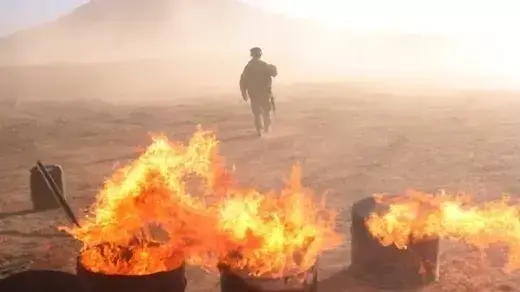




















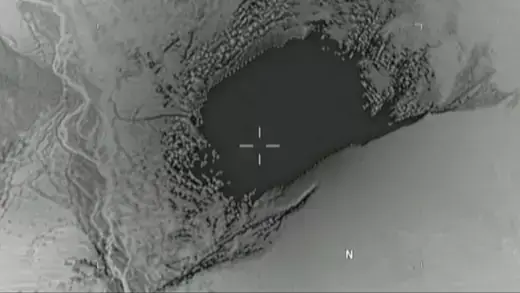
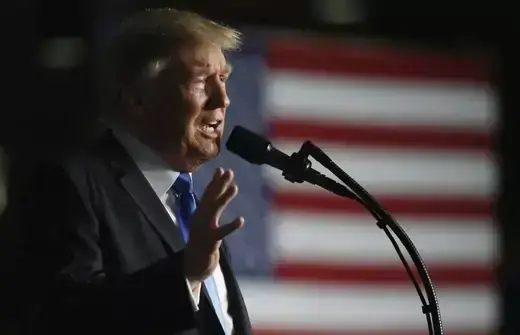


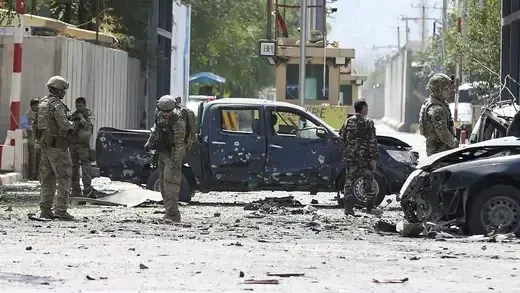

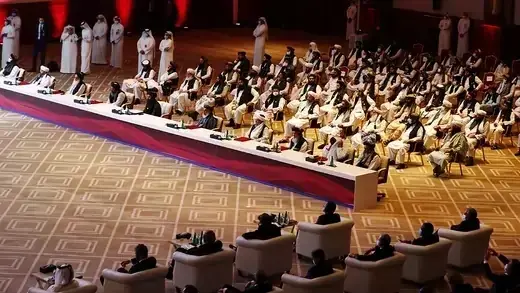
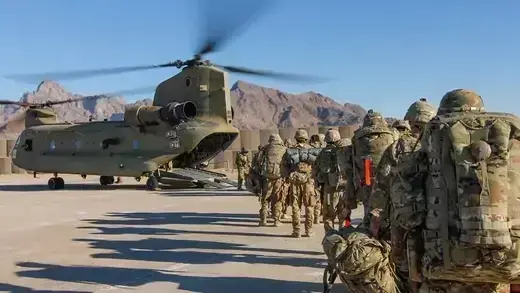
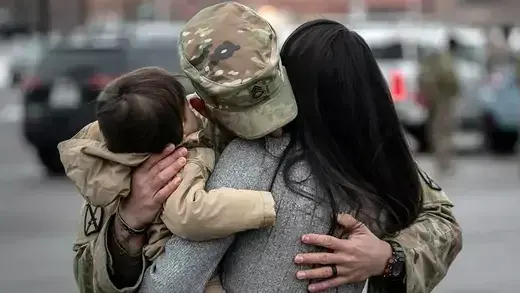
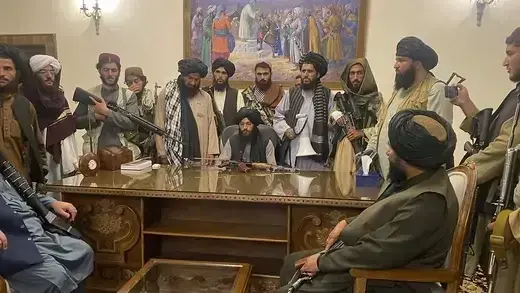

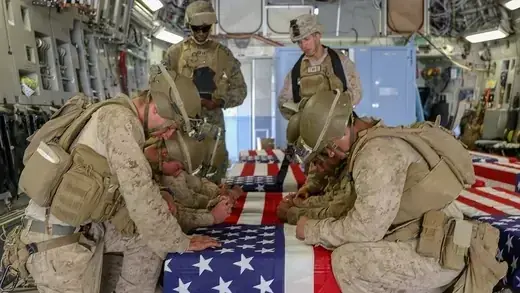
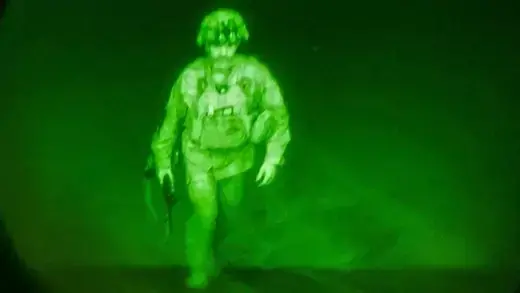
0 Response to "If a Country Surrender That Country Would Never Rise Again"
إرسال تعليق